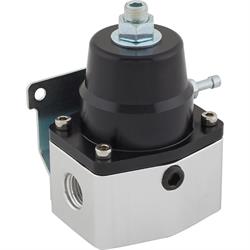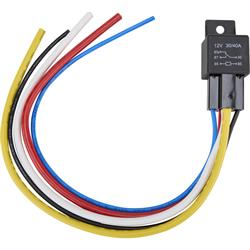Electric Fuel Pumps vs Mechanical Fuel Pumps: What Is Best For Your Application
Don’t Be “Fuelish” When It Comes to Feeding Your Engine the Proper Fuel Pressure
At the dawn of the automotive age the internal combustion engine used in most vehicles didn’t use a fuel pump. They simply housed a fuel storage tank higher than the carburetor mounted on the engine and let gravity do its thing. These fuel tanks were usually mounted in the cowl or dash or under the front seat area. Some designs did not fare too well going up steep hills (looking at you Ford Model T), plus with the desire to make cars safer by moving the fuel tank to the rear of the vehicle since most owners didn’t have a “warm and fuzzy” about sitting on a gas tank, the need arose to add a fuel pump to the system to ensure an adequate supply of fuel to the engine.
It is easy to assume that all these early carbureted engines used a mechanical fuel pump driven off some rotating part of the engine, but in fact, there were several manufacturers that used both in-tank and external electric fuel pumps as far back as the late 1920s. Electric fuel pump use really didn’t gain popularity, however, until the modern electronic fuel injection age starting in the mid-to-late 1980s. Meanwhile, the hardy mechanical fuel pump would see plenty of service throughout the 20th century until EFI became the sole fuel delivery source for internal combustion engines in cars and trucks.
What is The Difference Between a Mechanical and Electric Fuel Pump?
While it would be obvious to state one is mechanically actuated and the other electrically actuated, it goes way beyond that when comparing these two main fuel pump types. We’ll start with the mechanical fuel pump, as that has had a much larger installed base over the years and what many are familiar with when working on a classic hot rod or muscle car.
Mechanical fuel pumps are mounted to the vehicle’s engine and are actuated by a lever that rides on a fuel pump acentric or cam lobe (the SBC mechanical fuel pump uses a pushrod between the pump and camshaft, as does the BBC, while Ford and Mopar are direct acting). This lever creates a suction that pulls fuel from the fuel tank and delivers it to the carburetor. Mechanical pumps have a pre-set fuel pressure that works with typical two and four barrel carburetors, both OE and aftermarket models (though they can be regulated down if needed for special carburetion setups). A mechanical fuel pump does not require a fuel return line to the tank; however, you may come across some mechanical fuel pumps in OE applications that did have return lines. We offer several Holley mechanical fuel pump applications for your project vehicle.
A mechanical fuel pump is quiet in operation and generally cannot be heard when pumping. They can be tested easily with a vacuum and fuel pump tester right on the engine without removal by performing a mechanical fuel pump vacuum test. If there is any down side to a mechanical fuel pump it is that it cannot provide enough pressure and volume for fuel injection conversions (though they can be used to provide fuel to a surge tank setup for EFI, such as the models from Edelbrock and FiTech), and since they do not pump fuel unless the engine is cranking it can take an extended cranking period to start a car that sits a long time where the fuel has evaporated from the carburetor bowls and fuel line. If your battery is marginal (get yourself a battery tender if you don’t already have one!) you might end up with a dead battery before you have enough fuel from your SBC fuel pump to start the engine!
Electric fuel pumps are available for both carbureted and fuel injected applications in a myriad of setups. You’ll find inline electric fuel pump models that mount on the frame rail or body (universal electric fuel pump) and pumps that fit inside the fuel tank or fuel cell (either as a direct fit or a universal retrofit application). Unlike the mechanical fuel pump, which sucks or “pulls” the fuel from the tank, the electric fuel pump pushes the fuel to the engine, so they must be mounted as close to the fuel tank as possible and lower than the fuel tank, when using an external electric fuel pump kit, for proper feeding of the fuel supply to the pump to prevent starvation and burning up the pump. The fuel passing through the pump helps keep the electric motor cool, and without the fuel not only will the engine lose power or stall, but you run the chance of ruining your fuel pump, so mounting can be critical and one reason we recommend an in-tank pump retrofit if one is available.
Due to the higher pressures electric fuel pumps run, most, if not all, will require a return or “bypass” style regulator to allow proper control of the fuel pressure to the engine. This is especially critical with fuel injection. Though a low pressure electric fuel pump for carburetor applications can often get by with a “dead head” regulator, you can run into fuel pressure “creep,” thus we highly suggest a return line with bypass regulator for those carbureted setups using the higher pressure electric fuel pumps as well.
Unlike mechanical pumps, electric fuel pumps do have some audible operational noise. How much depends upon the size of the pump motor, motor design, and how and where it is installed. In-tank fuel pumps will be the quietest but can sometimes still be heard over the typical performance exhaust system. An inline fuel pump that is frame/body mounted, like any external fuel pump will create more noise but can be quieted some with insulated mounts. Testing electric fuel pumps can be accomplished on or off the car depending upon access and requires a high pressure fuel tester. Finally, unlike mechanical pumps, an electric fuel pump will pump fuel as soon as power is provided to the pump via the ignition switch, dash toggle, etc. so that you can easily prime the carburetor before starting the vehicle, which is advantageous for vehicles that sit for extended periods of time. We do suggest wiring any electric fuel pump through a relay to protect your vehicle's wiring unless your aftermarket EFI system comes with an integral fuel pump relay and wiring already.
What Fuel Filter Should I Use?
Just like there are differences in mechanical and electric fuel pumps, there are difference in their filtration needs as well. A mechanical pump can get by with an inline fuel filter between the pump and carburetor. This would usually be a 40 micron filter media, either in a serviceable housing or in a single use replaceable filter. For mechanical pumps, a pre-filter is not usually necessary, as the in-tank pickup assembly will have a filter “sock” attached. However, when it comes to inline electric fuel pumps for fuel injection it is imperative that a pre-filter is used. For an inline electric fuel pump, a 100 micron pre-filter is required and the post filter should be increased to a 10 micron filter to provide ample protection for the fine internals of the fuel injectors. For LS swaps we offer a unique filter with built in regulator that provides an all-in-one solution and keeps the return line to the tank nice and short (only needs to travel from the filter back to the tank, not all the way from the engine compartment).
What Should My Fuel Pressure Regulator Be Set At?
Whether you are running single or multiple carburetors, or throttle body or direct port fuel injection, you will most likely be running a fuel pressure regulator of some sort to ensure your carburetor or fuel injectors are fed the proper fuel pressure. Here is a little tip sheet we have provided that should get you up and running but note that every system is different and best settings will be found with thorough tuning on an engine or chassis dyno.








